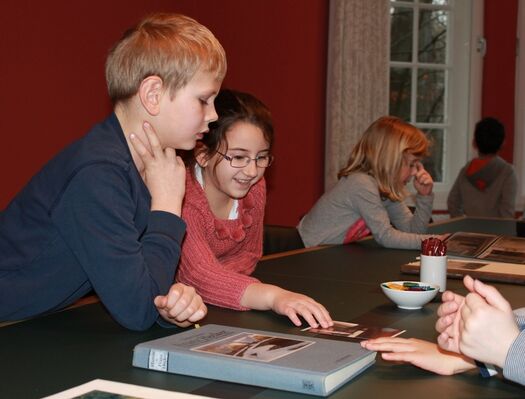In the footsteps of Franz Hecker

Primary school children discover the life of the Osnabrück artist
How did the Osnabrück painter Franz Hecker actually live? What did he paint and how did he make his paintings? What was going on in his time? The students of the Franz Hecker Elementary School dealt with these questions during their project week - they also visited the former home of the Osnabrück artist. Franz Hecker lived and worked in the Villa am Schölerberg from 1912 until his death in 1944.
At that time, the Villa Hecker was the only building on the Schölerberg. When Carl hears that Hecker sought this solitude in order to devote himself to his painting in peace, the seven-year-old comments with a meaningful, "Artist..." Carl and the other children have taken a seat in the former studio for the lecture. "Exciting," six-year-old Janneke finds it, sitting where many of the paintings were created that the painter, who was born in Bersenbrück in 1870, made mainly with motifs and people from the region. "Beautiful," the girl comments on the painter's works, which are on display at Villa Hecker. Then she and the others explore the house, which was built entirely according to Franz Hecker's wishes.
Uta Gewicke explains everything that has happened in this building over the past 100 years. She is an advisor to the Friedel & Gisela Bohnenkamp Foundation, which has been based in the villa for three years - and has had the building extensively renovated. The children curiously follow the traces of the renovation, they leaf through books about Franz Hecker's life and work - and are amused by photos of dormice that have lived in the house from time to time.
Every two years, teachers and students at the Franz Hecker School devote themselves intensively to one topic during a project week. "It is important to me that the person who gave our school its name is also dealt with, so that the children get to know him better," says principal Heike Spoo-Keßling. The children deal with the respective topic across all grades. They have come closer to Franz Hecker's lifetime during a journey through time. One class went on a hike in the footsteps of the artist, who is buried in the Johannis cemetery. Others have painted pictures of Franz Hecker. Still others have dealt with the question of what it must have been like to attend school in Franz Hecker's time.
"He is said to have been very friendly and liked children very much," Uta Gewicke recounts of the life of the painter, who lived in the villa with his mother, sister and a housekeeper. In November 1944, he took shelter in an air raid shelter on the Schölerberg with his sister and housekeeper and 93 other people, including numerous children.
As a result of a bomb attack, however, they all died of carbon monoxide poisoning. Among the victims were also many students of the former elementary school on the Schölerberg, which had been founded in 1909. Since 1972 it has borne the name of the Osnabrück artist.
Media contact: Dr. Marie-Luise Braun, Tel. 0541. 68 53 336, presse@bohnenkamp-stiftung.de